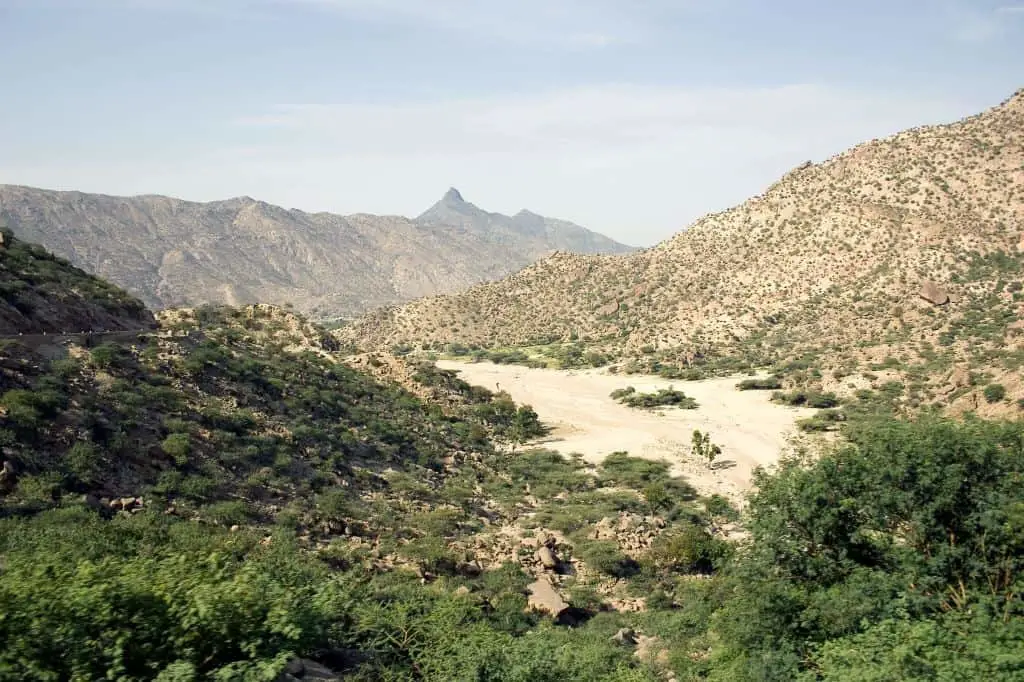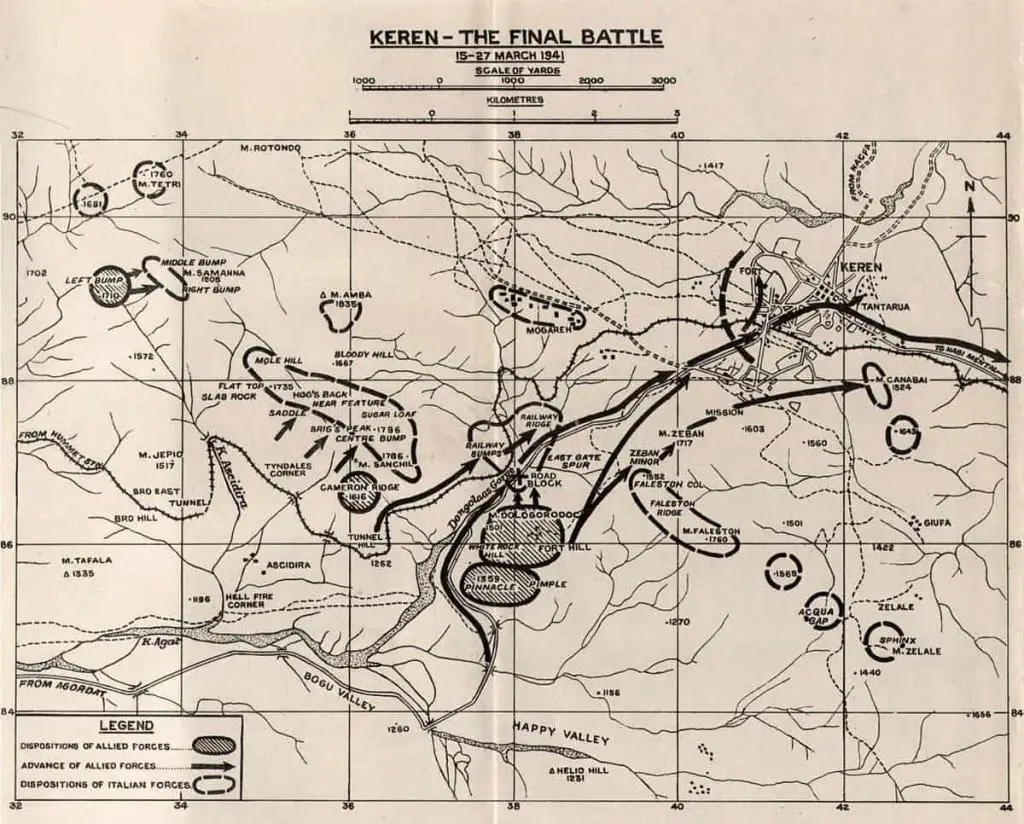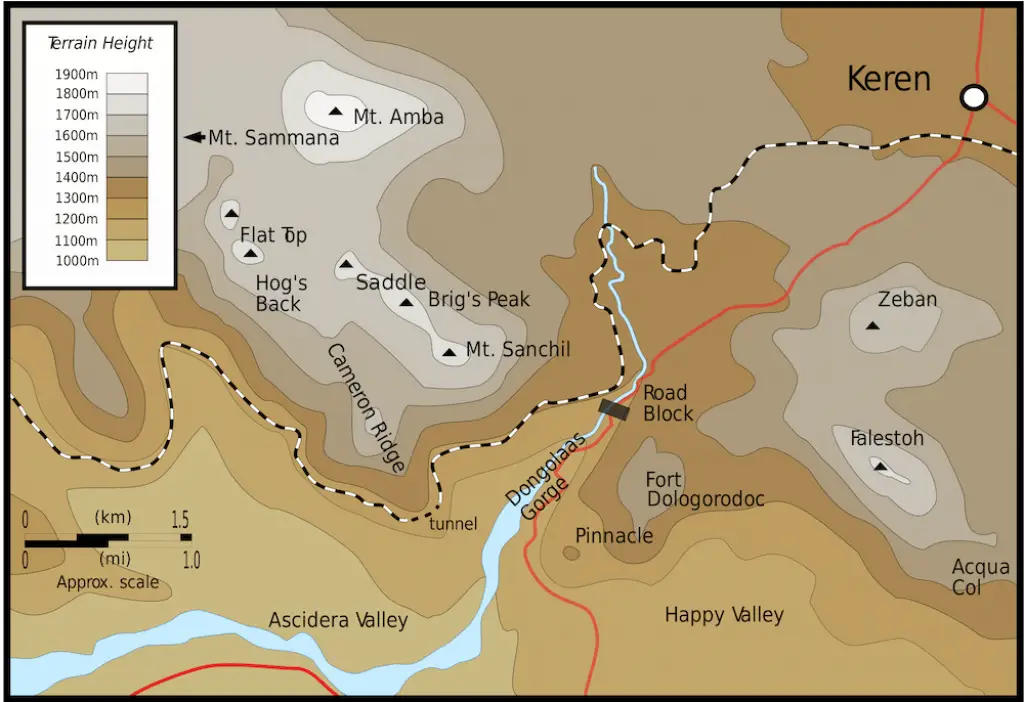What was the Battle of Keren
The Battle of Keren was fought between Italian and British/Commonwealth forces from 2 February to 27 March 1941 in the highlands of Eritrea. It was a hard fought battle that lasted 56 days. The Italians provided a stiff resistance but ultimately lost. This significant Allied victory ultimately doomed Italian East Africa.
The Keren Highlands
The Battle of Keren is located in the highlands where terraces slope toward Sudan. The battlefield contained no fortified emplacements or defensive buildings, only Italians determined not to give in. However, the Italian defensive positions were located inside an amphitheater of mountains. The Dongolaas ravine lay in the southwest where the road and the Agordat-Asmara railway ran. Additionally in the north near the Anseba ravine, lay the track bound to Cubub.
The Dongolaas ravine was the most important strategic point and also the easiest to defend. In the southwest lay the Dologorodoc mountain and in the northwest the Sanchil mountain. They are linked to the natural rampart at Monte Forcuto by a saddle called Height 1616.
Italians Bunker Down
All these locations witnessed ferocious battles. To the detriment of the Italians, the garrison couldn’t build bunkers or trenches in the rocky soil.
The first unit to be ordered to dispatch to Keren was the 11th Savoy Grenadiers Regiment. It included two Grenadier battalions (1st and 2nd), 3rd Bersaglieri Battalion and one Mortar company. They departed from Addis Ababa, where they conducted garrison duties and arrived in Keren on 1 February. The voyage was met with continuous harassment by the Royal Air Force (RAF). Additionally, the 2nd Battalion was assigned the Dongolaas ravine, and the Bersaglieri blocked the track to Cubub.
Italian Forces at Battle of Keren
General Nicolangelo Carnimeo
1 to 6 February 1941
11º Reggimento Granatieri di Savoia [Colonnello Corso Corsi]
– I Battaglione Granatieri
– II Battaglione Granatieri
– III Battaglione Bersaglieri
– 1 Mortar Company, 81mm
XI Colonial Brigade [Colonnello Francesco Prina]
– LI Colonial Battalion
– LII Colonial Battalion
– LVI Colonial Battalion
– LXIII Colonial Battalion
III Colonial Cavalry Squadron Group – Removed and re-inserted during the second battle phase.
XVth Colonial Cavalry Squadron Group – Removed and re-inserted during the second battle phase.
104th/CIV National Artillery Group 77/28
106th/CVI National Artillery Group (5th Brigade)
II Colonial Artillery Group 65/17
V Colonial Artillery Group 65/17
1st Battery Position A
3rd Battery Position 75/15
1st Engineering Company
Italian Reinforcements Added
7 to 13 February 1941
Alpini Battalion “Uork Amba” [Lieutenant Colonel Luigi Peluselli] of the 10th Regiment Granatieri di Savoia
II Colonial Brigade [Brigadier General Orlando Lorenzini]
– IV Battalion
– V Battalion
– IX Battalion
– X Battalion
– 151st/CLI Battalion
V Colonial Brigade [Colonel Ferdinando Oliveti]
– 97th/XCVII Battalion
– 106th/CVI Battalion
– “Tipo” Battalion
II Colonial Cavalry Squadron
I Battalion/60th National Field Artillery Regiment 65/17
XXXVI National Artillery Battalion 105/28
102nd/CII National Artillery Battalion – One Battery 77/28 from Amara
1 AT Battery 47/32 from Amara
1 AA Battery 20 mm from Amara
VI Colonial Artillery Group – with two batteries of the respective Colonial Brigade
XI Colonial Artillery Group – with two batteries of the respective Colonial Brigade
XII Colonial Artillery Group – with two batteries of the respective Colonial Brigade
14 February to 14 March 1941
11th/XI Blackshirt Legion [Consul Ugo Gresele] – Two Battalions
44th/XLIV Blackshirt Battalion
1 MG Battalion from 10th Regiment Granatieri di Savoia arriving from Metemma, Amara
3rd Royal Rifle Company Training
VI Colonial Brigade [Colonel Livio Bonelli] from Amara
– 19th/XIX Battalion
– 24th/XXIV Battalion
– 31st/XXXI Battalion
– 34th/XXXIV battalions
XII Colonial Brigade [Colonel Federico Rocco]
– 36th/XXXVI Battalion
– 41st/XLI Battalion
– 43rd/XLIII Battalion
– 103rd/CIII battalions
IV National Artillery Group 100/17 from Amara
CIII National Artillery Group 77/28 from Amara
XXII National AA Artillery Group 75/46 with two batteries
15 to 27 March 1941
150th/CL Blackshirt Battalion
170th/CLXX Blackshirt Battalion
41st/XLI Colonial Brigade [Lieutenant-Colonel Tito Badi]
– UNK Battalion
– 131st/CXXXI Battalion
– 132nd/CXXXII Battalion
61st/LXI Colonial Brigade [Lieutenant-Colonel Mario Giordano]
– UNK Battalion
– 57th/LVII Battalion
XVI Colonial Brigade [Colonel Manlio Vanetti]
-22nd/XXII Battalion of the 8th Colonial Brigade
– 33rd/XXXIII Battalion of the 8th Colonial Brigade
– 35th/XXXV Battalion of the 8th Colonial Brigade
Commonwealth Forces at Keren
Against these forces lay the 4th Anglo-Indian Division which obtained victory at Agordat. It included two Indian Brigades (V and VII), a Scottish battalion (Black Watch), some motorized units and the Gazelle Force. Reinforcements from the 5th Division, the Sudan Defense Force and other Sudanese battalions would later be added thus reaching a total of 51,000 men.
Victory and Attrition of the Defenders (2-14 February)
The first phase of the Battle of Keren showed the stubborn and brilliant Italian resistance at the Dongolaas ravine and the surrounding peaks and valleys. Already on 02 February, enemy armored units tried to penetrate the ravine but were stopped by a mine set off by the Italians in order to block the passage. The next day, Commonwealth forces attempted to conquer the peaks around the ravine. Additionally, the Queen’s Own Cameron Highlander’s moved in to attack and take Height 1616 from a company of the 2nd Granatieri Battalion.
The counterattack meant to retake Sanchil peak could not be carried out because it was anticipated by the advance of the Punjab and Rajputana regiments. Its members are renowned for being tough and brave soldiers. The attackers almost conquered the last emplacements held by the decimated Granatieri di Savoia. Meanwhile, the arrival of two companies of the III Bersaglieri and of the XCVII Colonial Battalion pushed them back into the ravines. The struggle that took place that terrible day among precipices and thorny acacias tearing flesh and clothes off men turned into bloody close quarter combat, However, the struggle also showed the unshakable will of the Italians not to yield. On 10 February, it was clear that the Anglo-Indians were preparing a new and massive infantry assault. A subsequent motorized assault would follow.
The Italians Push Back
The Italian command at the Keren stronghold concentrated all available men around Dongolaas, including the newly arrived Uork Amba Alpini Battalion. During the dawn of 12 February at dawn, the British offensive started. The battle raged for two days and saw the dreaded Indian battalion of the Maharatta and the ferocious Sikhs joining the fray. However, on the afternoon of the 14, Italians could see the British tanks, which had waited for an infantry breakthrough, withdraw westwards. As a result, the Italian flag kept flying on the bloodstained heights of Keren. Grenadiers, Alpini, Blackshirts, and Ascari obtained a marvelous victory, but at a very high price.
Keren is proving itself to be a tough nut to crack[…] The enemy is ferociously and repeatedly counterattacking us and, even if its losses have been exceedingly heavy, there’s no immediate sign of yielding.
Standstill and Adjustments on the Front
From 15 February to 4 March 1941, excluding the action on the Cubub emplacement north of Ambesa, the Southwest Front became stabilized due to the exhaustion from both sides. Additionally, the Italians received additional reinforcements from Gondar and Addis Ababa (10th Regiment Savoy Grenadiers). But the battalions in Keren were often down to 150-200 men each. The battalions were more or less like a company. Even though for that month there was no infantry slaughter, the guns did not remain silent. The Italian emplacement at Keren received intense artillery fire and strafing from the Royal Air Force (RAF). By the is time, the Regia Aeronautica at Keren no longer existed and the RAF dominated the skies.
As an official British report states: Between 15 and 22 March 1941, British artillery fired an astonishing 110,000 rounds against the Italian defenders.

The Tragic Epilogue (15-27 March 1941)
Do not let anybody think this is going to be a walk-over. It is not. It’s going to be a bloody battle: a bloody battle against both enemy and ground. It will be won by the side which lasts longest. I know you will last longer than they do. And I promise you I will last longer than my opposite number.
The last British offensive included an assault on Keren from two directions:
- From the North with troops coming from Karora and re-enforced by the French 13th Demi-Brigade of the Foreign Legion. (Consequently, they would see action at Dien Bien Phu thirteen years later.)
- From South-West with the 4th and 5th Indian Division
The 4th Division was to take the Sanchil and Monte Forcuto that the British abandoned due to the tenacious Italian counterattack on 12 February. The 5th was to force through the Dongolaas ravine. Troops coming from Karora were to engage on the Italian forces. Meanwhile, intense shelling and bombing preceded the attack.
The Italian emplacements on Samanna, Dologorodoc, Amba, Forcuto, Sanchil, and Dongolaas mountains literally disappeared under an immense cloud of smoke and dust. Meanwhile, in front massed the first British assault waves: the 2nd Highland Light Infantry, the IX and XXIX Indian Brigade.
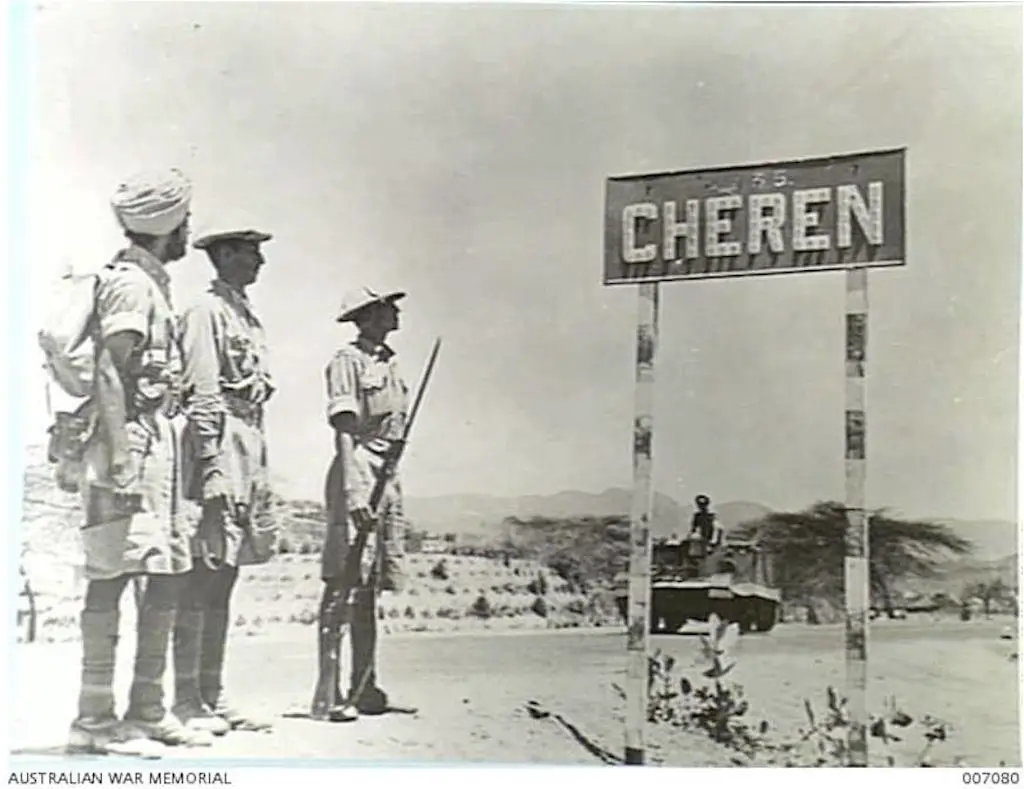
Keren was known as Cheren to Italians. Here is a signpost on the road with the Indian Army.
Offensive Begins
The general offensive began at 0800 hours of 15 March. At first, it didn’t go well for the attackers. British infantry was pushed back everywhere by lobbing Italian hand grenades. Additionally, British tanks that tried to force through the Dongolaas road were stopped by Italian batteries, mortars, and buried incendiary devices.
In the North astride the Anseba Pass, the II and VI Italian Brigade brilliantly repulsed a Foreign Legion attempt to outflank them.
British Progress
The next day, the British began making the first progress in the tricky Dologorodoc sector. As a result, the Italian command dispatched all available reinforcements, including Carabinieri and two newly arrived colonial battalions. However, these small Italian units were already decimated by the RAF even before they arrived at the front line. Consequently, they were useless against the joint attack of two divisions.
Additionally, the presence of the Regia Aeronautica at Keren was practically symbolic. Keren had three SM.79 bombers and an SM.81, while the British had dozens of fighters and light bombers at their disposal.
For an entire week, Italian counterattacks on the Sanchil and the Dologodoroc were pushed back almost exclusively from the air. Air attacks even demoralize the Ascari, who otherwise fought bravely.
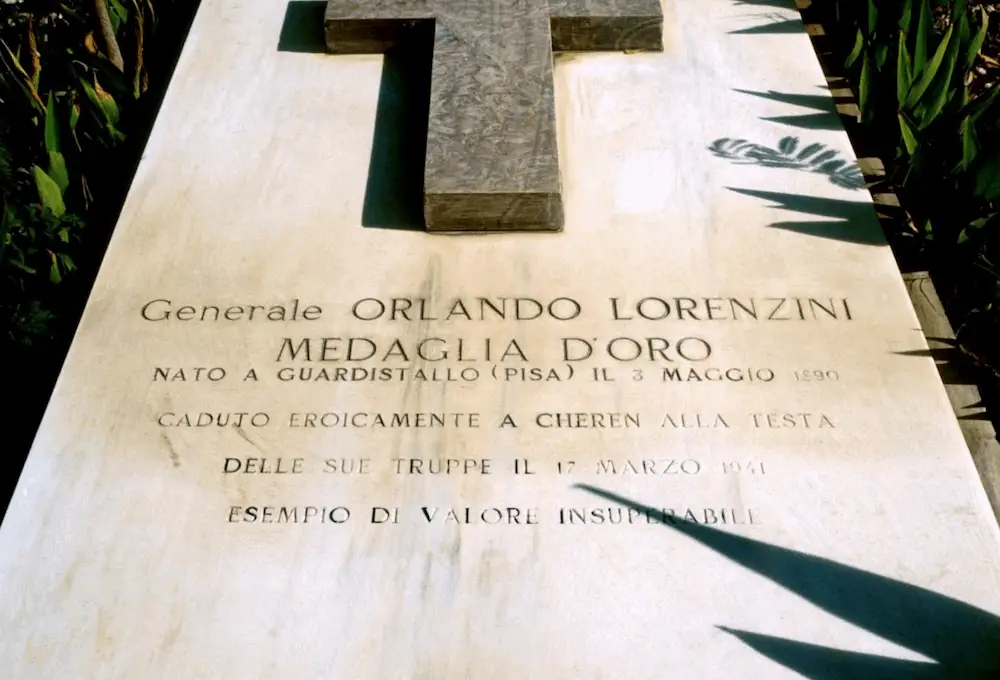
The grave of Brigadier General Orlando Lorenzini located at the military cemetery in Keren. Lorenzini was killed on 17 March 1941 in the Battle of Keren. Image: Nicky Di. Paolo.
The operations on the Northern front were at a standstill. But the main sector, the Southeastern, continued with strafing and bombing of Italian positions with frantic intensity. The Southeastern offensive was, in fact, the keystone of the whole offensive. At Keren, there was no sudden breakdown from the strafing and bombing. The defenses of Keren simply ceased to exist due to attrition of the garrison. Reserves kept on immolating themselves in obstinate counterattacks. Entire battalions lay buried on the very positions they defended until there were no more battalions, no more reserves, no more men because the garrisons had been annihilated in battle.
On 26 March, British engineers reopened the Dongolaas ravine to their tanks exactly as the last suicide attack of Ascari and blackshirts took place. But on the 27th, the Keren stronghold ceased to exist.
Who fought on other fronts knows that nothing, nothing was worse than Keren!
After Keren
On 31 March the last defensive line fell at Teclasan. On 8 April, Massawa also surrendered. Massawa lay uselessly defended by a few hundred sailors who had scuttled ships that could not sail. In addition to the sailors were a handful of Revenue Guards and about one thousand survivors of Keren.
In short, Eritrea was lost. Out of the 40,000 men who heroically fought at Keren for 56 days, 8,000 died, 21,000 wounded, some hundreds taken prisoner. Similarly, the British lost 536 killed and 3,229 wounded. But, resistance and guerrilla fighting continued for a few months, in some cases until 1943.
The colonial war in Italian East Africa ended with the conquest of Gondar on 28th November 1941.
OOB Sources
ROVIGHI Alberto, Le operazioni in Africa Orientale (Giugno 1940-Novembre 1941)
USACAC.army.mil
Baker, Arthur J., Eritrea 1941 Faber; First edition. 1966
